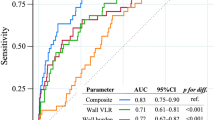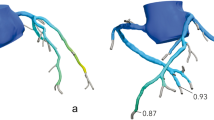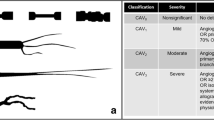Abstract
Cardiac allograft vasculopathy (CAV) is a significant determinant of long-term survival in heart transplant recipients. Standard CAV screening typically utilizes invasive coronary angiography (ICA). Quantitative flow ratio (QFR) is a computational method for functional testing of coronary stenosis, and may add diagnostic value to ICA in assessing CAV. Consecutive subjects who received heart transplantation and underwent two separate routine coronary angiograms between January 2013 and April 2016 were enrolled. Coronary angiograms and IVUS were performed per local protocol at 1, 2, 3 and 5 years post-transplant. QFR was calculated offline. CAV was assessed semi-quantitively based on coronary angiogram results. Twenty-two patients were enrolled. Mean time from transplant to first included ICA was 2.1 years. QFR in at least 1 coronary vessel was interpretable in 19/22 (86%) of initial ICA (QFR1). QFR1 correlated well with the CAV score derived from the second ICA (CAV2) with a clustering of CAV at lower QFR values. In a receiver-operating characteristic (ROC) analysis, an optimal QFR threshold of 0.88 yielded 0.94 sensitivity and 0.67 specificity (AUC of 0.79) for at least non-obstructive subsequent CAV. Initial angiographically and intravascular ultrasound derived CAV severity poorly predicted subsequent CAV severity. QFR derived from invasive coronary angiography predicts subsequent development of CAV more accurately than angiography and intravascular ultrasound. This novel method of coronary flow assessment in recipients of heart transplantation may be useful to diagnose and predict subsequent CAV development.



Similar content being viewed by others
Abbreviations
- CAV:
-
Cardiac allograft vasculopathy
- ICA:
-
Invasive coronary angiography
- IVUS:
-
Intravascular ultrasound
- FFR:
-
Fractional flow reserve
- LAD:
-
Left anterior descending coronary artery
- LCX:
-
Left circumflex coronary artery
- PCI:
-
Percutaneous coronary intervention
- QCA:
-
Quantitative coronary angiography
- QFR:
-
Quantitative flow ratio
- RCA:
-
Right coronary artery
- SCD:
-
Sudden cardiac death
References
Lund LH, Edwards LB, Kucheryavaya AY et al (2013) The registry of the international society for heart and lung transplantation: thirtieth official adult heart transplant report—2013; focus theme: age. J Heart Lung Transplant 32(10):951–964. https://doi.org/10.1016/j.healun.2013.08.006
Lund LH, Edwards LB, Kucheryavaya AY et al (2015) The registry of the International Society for Heart and Lung Transplantation: thirty-second official adult heart transplantation report–2015; focus theme: early graft failure. J Heart Lung Transplant 34(10):1244–1254. https://doi.org/10.1016/j.healun.2015.08.003
Schmauss D, Weis M (2008) Cardiac allograft vasculopathy: recent developments. Circulation 117(16):2131–2141. https://doi.org/10.1161/CIRCULATIONAHA.107.711911
Ortega-Legaspi JM, Bravo PE (2021) Diagnosis and management of cardiac allograft vasculopathy. Heart. https://doi.org/10.1136/heartjnl-2020-318063
Chih S, Chong AY, Mielniczuk LM et al (2016) Allograft vasculopathy the Achilles’ heel of heart transplantation. J Am Coll Cardiol 68(1):80–91. https://doi.org/10.1016/j.jacc.2016.04.033
Mehra MR (2006) Contemporary concepts in prevention and treatment of cardiac allograft vasculopathy. Am J Transplant 6(6):1248–1256. https://doi.org/10.1111/j.1600-6143.2006.01314.x
Eisen HJ, Tuzcu EM, Dorent R, RAD B253 Study Group et al (2003) Everolimus for the prevention of allograft rejection and vasculopathy in cardiac-transplant recipients. N Engl J Med 349(9):847–858. https://doi.org/10.1056/NEJMoa022171
Eisen HJ, Kobashigawa J, Starling RC et al (2013) Everolimus versus mycophenolate mofetil in heart transplantation: a randomized, multicenter trial. Am J Transplant 13(5):1203–1216. https://doi.org/10.1111/ajt.12181
Costanzo MR, Dipchand A, Starling R, International Society of Heart and Lung Transplantation Guidelines et al (2010) The International Society of Heart and Lung Transplantation Guidelines for the care of heart transplant recipients. J Heart Lung Transplant 29(8):914–956. https://doi.org/10.1016/j.healun.2010.05.034
Pollack A, Nazif T, Mancini D, Weisz G (2013) Detection and imaging of cardiac allograft vasculopathy. JACC Cardiovasc Imaging 6(5):613–623. https://doi.org/10.1016/j.jcmg.2013.03.001
Olymbios M, Kwiecinski J, Berman DS, Kobashigawa JA (2018) Imaging in heart transplant patients. JACC Cardiovasc Imaging 11(10):1514–1530
Yang HM, Khush K, Luikart H et al (2016) Invasive assessment of coronary physiology predicts late mortality after heart transplantation. Circulation 133(20):1945–1950. https://doi.org/10.1161/CIRCULATIONAHA.115.018741
Ahn JM, Zimmermann FM, Arora S et al (2021) Prognostic value of comprehensive intracoronary physiology assessment early after heart transplantation. Eur Heart J 42(48):4918–4929. https://doi.org/10.1093/eurheartj/ehab568
Khandhar SJ, Yamamoto H, Teuteberg JJ et al (2013) Optical coherence tomography for characterization of cardiac allograft vasculopathy after heart transplantation (OCTCAV study). J Heart Lung Transplant 32(6):596–602. https://doi.org/10.1016/j.healun.2013.02.005
Acharya D, Loyaga-Rendon RY, Chatterjee A et al (2021) Optical coherence tomography in cardiac allograft vasculopathy: state-of-the-art review. Circ Heart Fail 14(9):e008416. https://doi.org/10.1161/CIRCHEARTFAILURE.121.008416
Nous FMA, Roest S, van Dijkman ED et al (2021) Clinical implementation of coronary computed tomography angiography for routine detection of cardiac allograft vasculopathy in heart transplant patients. Transpl Int 34(10):1886–1894. https://doi.org/10.1111/tri.13973
Feher A, Srivastava A, Quail MA et al (2020) Serial assessment of coronary flow reserve by rubidium-82 positron emission tomography predicts mortality in heart transplant recipients. JACC Cardiovasc Imaging 13(1 Pt 1):109–120. https://doi.org/10.1016/j.jcmg.2018.08.025
Xu B, Tu S, Qiao S et al (2017) Diagnostic accuracy of angiography-based quantitative flow ratio measurements for online assessment of coronary stenosis. J Am Coll Cardiol 70(25):3077–3087. https://doi.org/10.1016/j.jacc.2017.10.035
Finizio M, Melaku GD, Kahsay Y et al (2021) Comparison of quantitative flow ratio and invasive physiology indices in a diverse population at a Tertiary United States Hospital. Cardiovasc Revasc Med 32:1–4. https://doi.org/10.1016/j.carrev.2021.06.115
Xu B, Tu S, Song L et al (2021) Angiographic quantitative flow ratio-guided coronary intervention (FAVOR III China): a multicentre, randomised, sham-controlled trial. The Lancet 398(10317):2149–2159. https://doi.org/10.1016/S0140-6736(21)02248-0
Spitaleri G, Brugaletta S, Potena L et al (2022) Role of quantitative flow ratio in predicting future cardiac allograft vasculopathy in heart transplant recipients. Circulation. https://doi.org/10.1161/CIRCINTERVENTIONS.121.011656
Mehra MR, Crespo-Leiro MG, Dipchand A et al (2010) International Society for Heart and Lung Transplantation working formulation of a standardized nomenclature for cardiac allograft vasculopathy-2010. J Heart Lung Transplant 29(7):717–727. https://doi.org/10.1016/j.healun.2010.05.017
Nørgaard BL, Terkelsen CJ, Mathiassen ON et al (2018) Coronary CT angiographic and flow reserve-guided management of patients with stable ischemic heart disease. J Am Coll Cardiol 72(18):2123–2134. https://doi.org/10.1016/j.jacc.2018.07.043
Acknowledgements
The authors are appreciative of the transplant recipients, their families, and the entire heart transplant team at MedStar Washington Hospital Center.
Funding
This study was investigator initiated and not supported with grant or industry funding.
Author information
Authors and Affiliations
Contributions
HS: Investigation, writing—original draft, visualization. IL: Validation, investigation, writing—original draft, visualization. SR: Validation, formal analysis, writing—review and editing. WS: Resources, writing—review and editing. MR: Resources, writing—review and editing. SM: Methodology, formal analysis, writing—review and editing, supervision. EM: Resources, writing—review and editing. HMG-G: Methodology, resources, writing—review and editing, supervision. BBK: Conceptualization, methodology, validation, investigation, data curation, writing—original draft, visualization, supervision, project administration. All authors have contributed to the manuscript and have approved it for the submission.
Corresponding author
Ethics declarations
Competing interests
Investigator HGG reports receiving institutional grants from Biotronik, Boston Scientific, Medtronic, Abbott Vascular, Neovasc, Shockwave, Phillips and Corflow. Investigator EM receives funding from Abbott. There are no other conflicts of interest to disclose.
Ethical approval
The study was approved by the institutional review board of the Medstar Washington Hospital Center with a waiver of consent. In addition, there was strict adherence to guidelines for rigorous reporting of results.
Additional information
Publisher's Note
Springer Nature remains neutral with regard to jurisdictional claims in published maps and institutional affiliations.
Rights and permissions
Springer Nature or its licensor (e.g. a society or other partner) holds exclusive rights to this article under a publishing agreement with the author(s) or other rightsholder(s); author self-archiving of the accepted manuscript version of this article is solely governed by the terms of such publishing agreement and applicable law.
About this article
Cite this article
Shah, H., Lee, I., Rao, S. et al. Quantitative flow ratio computed from invasive coronary angiography as a predictor for cardiac allograft vasculopathy after cardiac transplant. Int J Cardiovasc Imaging 40, 451–458 (2024). https://doi.org/10.1007/s10554-023-03012-8
Received:
Accepted:
Published:
Issue Date:
DOI: https://doi.org/10.1007/s10554-023-03012-8




